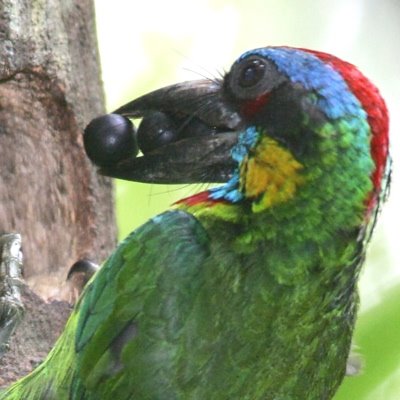One evening I found a package in my mailbox, left there by Meng and Melinda Chan. The pair was returning home from photographing a pair of nesting Red-crowned Barbet (Megalaima rafflesii) and left me the messy collection of partially digested fruits. Apparently Melinda collected them from the road nearby after the parent birds cleaned out their nest and dumped the trash some distance away.
The collection of fruits was fascinating. A few of the fruits had their bluish outer skin intact. Others were without the skin, the pulp greenish. There were a few other fruits/seeds as well, all covered with a dark, sticky and messy substance, probably originating from the rear end of the nestlings.
The bluish fruits still had a distinctive aromatic smell, reminiscence of some fruits or other that I cannot recollect. My first thought was Elaeocarpus or oil-fruit trees. These small to fairly large trees are common in our secondary forests. Their fruits ripen blue-green or blue-grey. The greenish pulp also pointed to this plant.
I checked with Ali Ibrahim who gave me some leads. Lauraceae or Elaeocarpaceae he suggested. The first includes wild cinnamon (Cinnamomum iners) while the second the oil-fruit trees, Elaeocarpus spp. The aromatic smell of the fruits suggested that it could not be the first. Cleaning the fruits and cutting it into two showed a very hard stone enclosing two seeds, each with its own cavity. Bingo! Elaeocarpus it is.
So these barbets eat Elaeocarpus fruits. They were brought to the nest and fed to the nestlings in twos and threes. Apparently the nestlings could not handle these fruits and most were probably regurgitated and deposited in the nest cavity. The parent birds had a hard time cleaning out the nest, literally carrying out these partially digested fruits in their beaks and dumping them onto the road nearby.
It has been reported that the nestlings of barbets dispose of their wastes through faecal sacs. Apparently these fruits/seeds were too large to be contained in such sacs, making it necessary for the parent birds to “shovel” them with their beaks.
Thank you Meng and Melinda Chan for collecting the fruits and for the image of the Barbet, and to Ali Ibrahim for help in the ID. Image of fruits by YC.










